
The Inyo Mountains are a short mountain range east of the Sierra Nevada in eastern California in the United States. The range separates the Owens Valley to the west from Saline Valley to the east, extending for approximately 70 miles (110 km) south-southeast from the southern end of the White Mountains, from which they are separated by Westgard Pass, to the east of Owens Lake.
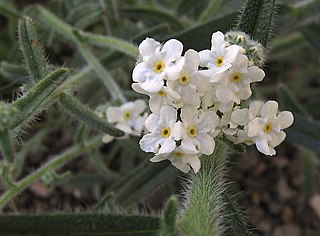
Cryptantha is a genus of flowering plants in the borage family, Boraginaceae. They are known commonly as cat's eyes and popcorn flowers. They are distributed throughout western North America and western South America, but they are absent from the regions in between.

Cryptantha affinis is a flowering annual plant occurring in open areas of the coniferous forest. It is a member of the family Boraginaceae. It occurs at elevation ranges between 700 – 2900 m. Cryptantha species occur with other genera such as Clarkia, Hesperolinon, Lasthenia, Lupinus, Mimulus and Phacelia.

The Madrean Region is a floristic region within the Holarctic Kingdom in North America, as delineated by Armen Takhtajan and Robert F. Thorne. It occupies arid or semiarid areas in the southwestern United States and northwestern Mexico and is bordered by the Rocky Mountain Floristic Region and North American Atlantic Region of the Holarctic Kingdom in the north and in the east, Caribbean Region of the Neotropical Kingdom in the south.

Cryptantha intermedia is a species of wildflower in the borage family known by several common names, including common cryptantha, Clearwater cryptantha, and nievitas.

Johnstonella angustifolia is a species of wildflower in the borage family known by several common names, including Panamint catseye and bristlelobe cryptantha. This plant is native to northern Mexico and the southwestern United States from California to Texas, where it grows in desert scrub and woodland.

Oreocarya virginensis is a species of wildflower in the family Boraginaceae known by the common name Virgin River cryptantha. This is a small plant native to the southwestern United States where it is a common plant in scrub and woodland. It is named for the Virgin River, a tributary of the Colorado River which runs through the region. This cryptantha is an annual or occasionally a perennial up to 40 centimeters in height. It is coated densely in long white hairs and bristles. The inflorescence is cylindrical or club-shaped, packed with tubular flowers with flat-faced corollas. The flower is usually bright white with yellow throat parts at the tube opening. The fruit is a rough, ridged nutlet.

Cryptantha muricata is a species of flowering plant in the borage family known by the common name pointed cryptantha. It is native to California and adjacent parts of Arizona, Baja California, and Nevada, where it is known from many habitat types. It is an annual herb producing a branching 10 centimeters to one meter in height which is coated densely in rough and soft hairs. The leaves are linear in shape and no more than 4 centimeters long. They have hairs and bristles, some of which have bulbous bases. The inflorescence is a length of very hairy developing fruits tipped with a cluster of small five-lobed white flowers.
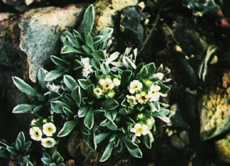
Oreocarya roosiorum is a species of flowering plant in the family Boraginaceae known by the common name bristlecone cryptantha.

Cryptantha crinita is a rare species of flowering plant in the borage family known by the common names Sacramento cryptantha and silky cryptantha. It is endemic to California in the United States, where it occurs in the northern Sacramento Valley and the adjacent edges of the Cascade Range foothills.
Cryptantha incana is a rare species of flowering plant in the borage family known by the common name Tulare cryptantha. It is endemic to California in the United States, where it occurs in the forests and woodlands of the southern Sierra Nevada. It is a poorly known species with three occurrences based on three historical collections. It was collected in Tulare County in 1904 and 1941 and once in Inyo County in 1989.

Cryptantha scoparia is a species of flowering plant in the borage family known by the common name Miners candle. It has been found in Idaho, Nevada, Montana, Wyoming, Utah, and Colorado but there have only been 5 confirmed sightings in recent years. It is a small slender herb which prefers open sunny sites often in semi arid canyons and hillsides.
Eriogonum crosbyae is a species of wild buckwheat known by the common name Crosby's buckwheat. It is native to southcentral Oregon and northwestern Nevada in the United States. Some treatments include plants in Montana and Idaho as members of this species. This plant was first discovered in the Guano Valley in Lake County, Oregon, in 1978 by Bureau of Land Management botanist Virginia Crosby, and it was named for her in 1981.
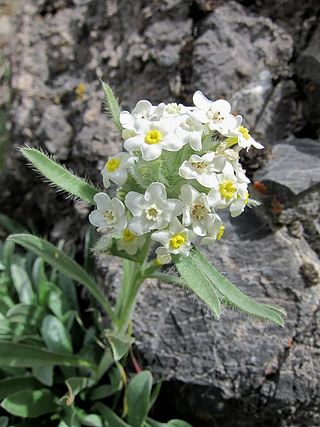
Cryptantha humilis is a perennial plant in the Borage Family (Boraginaceae). It is commonly called low cryptantha.
Cryptantha nubigena is a perennial plant in the Borage Family (Boraginaceae). It is commonly called Sierra cryptantha.
Cryptantha crymophila is a perennial plant in the family Boraginaceae. It is commonly called subalpine cryptantha.
Johnstonella is a genus of flowering plants belonging to the family Boraginaceae.
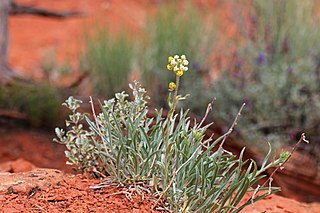
Oreocarya is a genus of flowering plants in the family Boraginaceae. There are about 63 species and its native range extends from western and central Canada, through western United States to north Mexico. It is part of subtribe of Amsinckiinae.
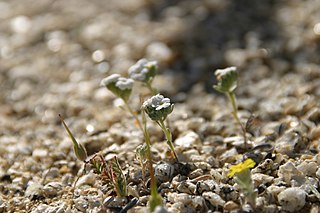
Eremocarya is a genus of flowering plants in the family Boraginaceae. There are about 63 species and its native range extends through western United States to northwestern Mexico. It is part of subtribe of Amsinckiinae.

Greeneocharis is a genus of flowering plants in the family Boraginaceae. There are about 63 species and its native range extends from western U.S.A. down to northwestern Mexico and to western Argentina. It is part of subtribe of Amsinckiinae.
This page is based on this
Wikipedia article Text is available under the
CC BY-SA 4.0 license; additional terms may apply.
Images, videos and audio are available under their respective licenses.















